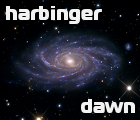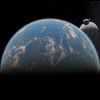|
Black Holes
|
|
| anonymousgamer | Date: Saturday, 30.06.2012, 14:24 | Message # 1 |
 World Builder
Group: Global Moderators
 United States
United States
Messages: 1011
Status: Offline
| http://jila.colorado.edu/~ajsh/insidebh/schw.html
I have no idea how hard this is to implement, probably impossible, knowing that this is some super advanced program he used. But, you know, just throwing the idea out there.
Desktop: FX-8350 4.0 GHz, 8 GB DDR3 RAM, EVGA GeForce GTX 1080 FTW 8 GB, 2 TB HDD, 24 inch 1920x1080 screen
Laptop: Core i5 480M 2.66 GHz (turbo 2.93), 8 GB DDR3 RAM, AMD Radeon HD 6550m 1 GB, 640 GB HDD, 17.3 inch 1600x900 screen
|
| |
| |
| HarbingerDawn | Date: Saturday, 30.06.2012, 18:52 | Message # 2 |
 Cosmic Curator
Group: Administrators
 United States
United States
Messages: 8717
Status: Offline
| I have thought about this before when flying near black holes in SpaceEngine. It would be very hard to implement, most likely beyond the ability of home computers to render in real time. But I'm sure that something could be done to improve the appearance of black holes, even though they already look pretty cool.
All forum users, please read this!
My SE mods and addons
Phenom II X6 1090T 3.2 GHz, 16 GB DDR3 RAM, GTX 970 3584 MB VRAM
|
| |
| |
| Talisman | Date: Saturday, 30.06.2012, 18:59 | Message # 3 |
 Pioneer
Group: Users
 United States
United States
Messages: 409
Status: Offline
| I love that link, that looks so scary, and that's most likely the closest we'll ever get to actually seeing how it would be to fly into a black hole. 
I don't think it would be hard to implement, as Harb said black holes already look awesome, but all it would take is a more prominent lens effect as you get closer. (You could probably simulate it manually using the fish eye lense setting and FOV).
On another note, does anyone know what the actual black hole is made of? Supermassive black holes are several thousands of kilometers wide, so what is it actually made of? Just neutrons packed tighter then a neutron star?

|
| |
| |
| anonymousgamer | Date: Saturday, 30.06.2012, 19:20 | Message # 4 |
 World Builder
Group: Global Moderators
 United States
United States
Messages: 1011
Status: Offline
| Quote (Talisman) On another note, does anyone know what the actual black hole is made of?
Literally, nothing. There is a singularity in the center..... made of stuff, but its infinitely small, with..... properties..? Someone else can explain these properties better.
But so yeah, the blackness is the event horizon, where the gravity is so strong all light gets pulled to the singularity. It's, I guess, just empty space where the laws of physics screw us over.
Edit: The link and Wikipedia, they'll give you answers
Desktop: FX-8350 4.0 GHz, 8 GB DDR3 RAM, EVGA GeForce GTX 1080 FTW 8 GB, 2 TB HDD, 24 inch 1920x1080 screen
Laptop: Core i5 480M 2.66 GHz (turbo 2.93), 8 GB DDR3 RAM, AMD Radeon HD 6550m 1 GB, 640 GB HDD, 17.3 inch 1600x900 screen
Edited by anonymousgamer - Saturday, 30.06.2012, 19:23 |
| |
| |
| HarbingerDawn | Date: Saturday, 30.06.2012, 19:45 | Message # 5 |
 Cosmic Curator
Group: Administrators
 United States
United States
Messages: 8717
Status: Offline
| Quote (Talisman)
I don't think it would be hard to implement, as Harb said black holes already look awesome, but all it would take is a more prominent lens effect as you get closer. (You could probably simulate it manually using the fish eye lense setting and FOV).
It would be hard to implement because you need to have a way of rendering the lens/warp effect with high quality (you'll notice that the current version gets very lo-res close up). And the exact lensing physics involved in making accurate-looking black holes are probably harder to implement and more resource-intensive that you might think. It might be possible, but it could also be deemed as low-priority since development time - and end-user system resources - could possibly be better allocated elsewhere. But that's just my own speculations, I don't have any particular knowledge on either point.
Quote (anonymousgamer) On another note, does anyone know what the actual black hole is made of? Supermassive black holes are several thousands of kilometers wide, so what is it actually made of? Just neutrons packed tighter then a neutron star?
Black holes are dimensionless; they have no size at all. That is what a singularity is, a simple point. Location without dimension. There is no known force that can support the mass of as much matter as a black hole would have, so it collapses into nothingness. But the mass is still there, at that location, even if it now has no form. What we typically think of as the "size" of a black hole is really the radius of its event horizon, the distance from the singularity where gravity becomes too powerful to permit light - and therefore anything else - from escaping.
It's all rather complicated and not intuitive at all in the details of how it works, and even the greatest scientists that have been studying this for decades still have many fundamental questions on the subject.
On the other hand, if there is a force strong enough to resist gravity in an object more massive than a neutron star, then there could be a massive compact object at the center of stellar-mass black holes, since the radius of such an object would be smaller than its event horizon, like a quark star or something even more exotic. But there is no evidence to support this.
All forum users, please read this!
My SE mods and addons
Phenom II X6 1090T 3.2 GHz, 16 GB DDR3 RAM, GTX 970 3584 MB VRAM
|
| |
| |
| Duke | Date: Saturday, 30.06.2012, 19:48 | Message # 6 |
|
Space Pilot
Group: SE team
 Antarctica
Antarctica
Messages: 88
Status: Offline
| There are already real-time implementation of some effects of such black holes:
Distortion of the stellar sky by a Schwarzschild black hole
http://www.vis.uni-stuttgart.de/~muelleta/IntBH/
Interactive visualization of a thin disc around a Schwarzschild black hole
http://www.vis.uni-stuttgart.de/~muelleta/IntThinDisk/
Visualizing circular motion around a Schwarzschild black hole
http://www.vis.uni-stuttgart.de/~muelleta/Torus/
|
| |
| |
| apenpaap | Date: Saturday, 30.06.2012, 19:52 | Message # 7 |
 World Builder
Group: Users
 Antarctica
Antarctica
Messages: 1063
Status: Offline
| Well, once a proper theory of quantum gravity is found, there will likely be no more singularity... We'll likely find that the core of a black hole is an incredibly dense and incredibly tightly packed collection of somethings, where the somethigns are smaller than quarks, and the whole thing will presumably be very small... But under current physics, we can't properly describe what happens after the pressure becomes so high neutrons, and then quarks, break down, so you end up with a single point of infinite density.
I occasionally stream at http://www.twitch.tv/magistermystax. Sometimes SE, sometimes other games.
Edited by apenpaap - Saturday, 30.06.2012, 19:52 |
| |
| |
| HarbingerDawn | Date: Saturday, 30.06.2012, 20:01 | Message # 8 |
 Cosmic Curator
Group: Administrators
 United States
United States
Messages: 8717
Status: Offline
| Quote (Duke) There are already real-time implementation of some effects of such black holes:
I did not know about this, thanks Duke. SpaceEngineer should see this if he hasn't already.
apenpaap, I completely agree. I was just restricting my explanation of black holes to known physics (which as you pointed out is inadequate to properly describe them).
All forum users, please read this!
My SE mods and addons
Phenom II X6 1090T 3.2 GHz, 16 GB DDR3 RAM, GTX 970 3584 MB VRAM
|
| |
| |
| anonymousgamer | Date: Saturday, 30.06.2012, 20:04 | Message # 9 |
 World Builder
Group: Global Moderators
 United States
United States
Messages: 1011
Status: Offline
| Quote (Duke) There are already real-time implementation of some effects of such black holes
You are my savior
Edit: Actually I have no idea how to use this software lol. 
Desktop: FX-8350 4.0 GHz, 8 GB DDR3 RAM, EVGA GeForce GTX 1080 FTW 8 GB, 2 TB HDD, 24 inch 1920x1080 screen
Laptop: Core i5 480M 2.66 GHz (turbo 2.93), 8 GB DDR3 RAM, AMD Radeon HD 6550m 1 GB, 640 GB HDD, 17.3 inch 1600x900 screen
Edited by anonymousgamer - Saturday, 30.06.2012, 20:20 |
| |
| |
| Talisman | Date: Saturday, 30.06.2012, 23:00 | Message # 10 |
 Pioneer
Group: Users
 United States
United States
Messages: 409
Status: Offline
| Quote (HarbingerDawn) The "size" of a black hole is really the radius of its event horizon
Quote (anonymousgamer) Literally, nothing
Ahaha, I wasn't thinking properly when I asked that. I just wanted to incite some discussion. 
I think how solid and "matter" like they look in space engine threw me off.
Quote But the mass is still there, at that location, even if it now has no form.
But it must have some form, even if we can't detect it, perhaps under such extreme gravitational forces it's crushed into basic boson particles while emitting everything else as hawking radiation. Although we can't even begin to accurately guess it's still fun to think about. There's most likely some quantum shenanigans going on that's actually really simple once we figure it out.

|
| |
| |
| HarbingerDawn | Date: Saturday, 30.06.2012, 23:30 | Message # 11 |
 Cosmic Curator
Group: Administrators
 United States
United States
Messages: 8717
Status: Offline
| Quote (Talisman) But it must have some form, even if we can't detect it
As apenpaap said, it probably does, but under our current understanding of physics no such structure can exist. So everything is condensed into a dimensionless point. It has no form, since form would require dimension. That is how black holes are understood according to known physical laws. In the future we will probably discover something that will shed light on the subject of black holes and determine their actual structure and composition, whatever that may be. But as of now, we don't know - physics says it's just a singularity.
Quote (Talisman) perhaps under such extreme gravitational forces it's crushed into basic boson particles while emitting everything else as hawking radiation
The central structure of the black hole does not emit any radiation. Hawking radiation is caused by anti-particle pairs popping into existence near the event horizon, then one particle is captured while the other escapes (or something like that).
All forum users, please read this!
My SE mods and addons
Phenom II X6 1090T 3.2 GHz, 16 GB DDR3 RAM, GTX 970 3584 MB VRAM
|
| |
| |
| Duke | Date: Sunday, 01.07.2012, 09:49 | Message # 12 |
|
Space Pilot
Group: SE team
 Antarctica
Antarctica
Messages: 88
Status: Offline
| Quote (anonymousgamer) You are my savior Edit: Actually I have no idea how to use this software lol.
Did you read installation manual for each of this demos?
|
| |
| |
| anonymousgamer | Date: Sunday, 01.07.2012, 12:01 | Message # 13 |
 World Builder
Group: Global Moderators
 United States
United States
Messages: 1011
Status: Offline
| Quote (Duke) Did you read installation manual for each of this demos?
Yeah, it's too confusing for my feeble mind. I thought it was kinda stupid how you had to download additional files, he should of just included them already.
Desktop: FX-8350 4.0 GHz, 8 GB DDR3 RAM, EVGA GeForce GTX 1080 FTW 8 GB, 2 TB HDD, 24 inch 1920x1080 screen
Laptop: Core i5 480M 2.66 GHz (turbo 2.93), 8 GB DDR3 RAM, AMD Radeon HD 6550m 1 GB, 640 GB HDD, 17.3 inch 1600x900 screen
|
| |
| |
| SpaceEngineer | Date: Monday, 02.07.2012, 05:13 | Message # 14 |
 Author of Space Engine
Group: Administrators
 Russian Federation
Russian Federation
Messages: 4800
Status: Offline
| To make the proper black hole visualization, I require only two things - rendering of entire scene in a cubemap (already done - fish-eye projection uses that) and a shader that takes the rendered cubemap and distorts it according to a real formula. Current black holes in SE uses simply background image instead of cubemap (it is almost free-of-charge, while rendering of a scene cubemap is very expensive), so SE cannot show you the light reaching the black hole from behind your back, curved and emitted back to your eyes. It just shows 8-shaped artifacts - edges of screen.
If the software that Duke has linked has good pdf's, is will be helpful for me to implement proper black holes in SE.
*

|
| |
| |
| mccordengineering | Date: Friday, 09.12.2016, 18:33 | Message # 15 |
|
Observer
Group: Newbies
 Pirate
Pirate
Messages: 2
Status: Offline
|  Ok, I'm just an engineer, not a physicist. (Yeah, I watch "Big Bang Theory" and accept my pathetic inferiority.) All that being said, I see black holes in a simpler light (or dark) without a lot of fancy formulas. This is my hypothesis which makes sense to me, but like most simplified things is probably full of holes (pun intended). Ok, I'm just an engineer, not a physicist. (Yeah, I watch "Big Bang Theory" and accept my pathetic inferiority.) All that being said, I see black holes in a simpler light (or dark) without a lot of fancy formulas. This is my hypothesis which makes sense to me, but like most simplified things is probably full of holes (pun intended).
Anyway, my understanding is that if the entire earth is crushed down to pure mass, it would be about the size of a golf ball. So, we would have a tiny black hole with an event horizon that would capture light that would be, I'm guessing, less than a mile in diameter. If the center of mass of the golf ball was in the same location as the center of the earth, the moon's orbit and all other things affected by the gravity of earth would remain unchanged. The only difference is that the mass is concentrated rather than distributed through a large planet. Since gravity increases by the square of distance, being within a few inches of the concentrated mass causes gravity to increase nearly infinitely (but not infinite) as compared to standing on the surface of the earth about 4000 miles from the center of mass that is actually distributed throughout the 4000 miles depending on density of the various earth layers, etc.
Now, if we accept that the volume of the earth can be compressed into a 1.68 inch diameter sphere, by applying the same compression ratio to the total mass of the known universe, everything could be compressed into a black hole mass that is roughly the size of Saturn. If we include the mass of dark matter, the diameter of the mass is still about the size of Jupiter. If that is the case, the diameter of even massive black holes throughout the universe would have to be less than a few miles.
In comparison to the entire volume of the universe, even a Jupiter size black hole would be relatively close to a singularity. The gravitational force and pressures inside such a mass would be tremendous. There is no space or particles that can vibrate to convert potential energy to kinetic energy to cool things down. Heat and pressure would reach close to infinite levels. It is a contest between the immovable object of infinitely dense mass and the irresistible force of heat. Something has to give. BANG!
As the sphere rips apart in a massive explosion, there is no reason it has to vaporize into its minuscule parts (bosuns or whatever). It seems to me that there would be chunks of black hole that stay together, especially in the outer layer. Of course, the chunks would instantly become spheres due to their immense gravity. Since nearly all galaxies have been found to have massive black holes at their centers, these chunks could be where the massive black holes came from.
Since all the debris from the explosion of a perfect sphere would radiate outward in all directions, it would make sense that the universe created from the debris would be expanding. The outer layers with less resistance to push against and more energy behind them would reach higher initial velocities than the inner layers. In fact, the mass at the very center of the black hole might not move at all.
As we on earth look behind us, since we are moving faster than the stars behind us (toward the source of the explosion), they seem to be moving away from us. As we look ahead, the stars are moving away because they are moving faster than we are. If we look to either side, the stars are moving away from us because they are radiating out at a different angle.
Now, isn't it possible that a large portion of the bosons (for lack of a better name for the smallest possible particle with mass) radiated out so quickly from the big bang that they never had a chance to combine with each other to form electrons or atoms? Could the dark mass in the universe just be free bosons that have never been able to combine? These particles have nearly no volume and are pure mass. Individually, they are undetectable from any distance but have a lot of gravity and mass when a large volume of space that they occupy is considered.
If we accept that the universe is infinite (if not, what is beyond it?) and that the mass and energy that make up the universe has been around forever, then giant black holes and big bangs are taking place all the time. As massive black holes gather mass from their galaxy or, more likely, a galaxy that its galaxy collides with, they grow to a critical size and then blow up and the whole thing starts all over again... infinitely. I suppose, if enough was known about it, the critical mass of a black hole could be calculated.
This, in a nutshell, is how I see black holes as an engineer. Is it totally insane or does some of it make sense? Do we really have to get into all the weird relativity stuff to discuss the shrapnel of the biggest blast in the universe?
|
| |
| |